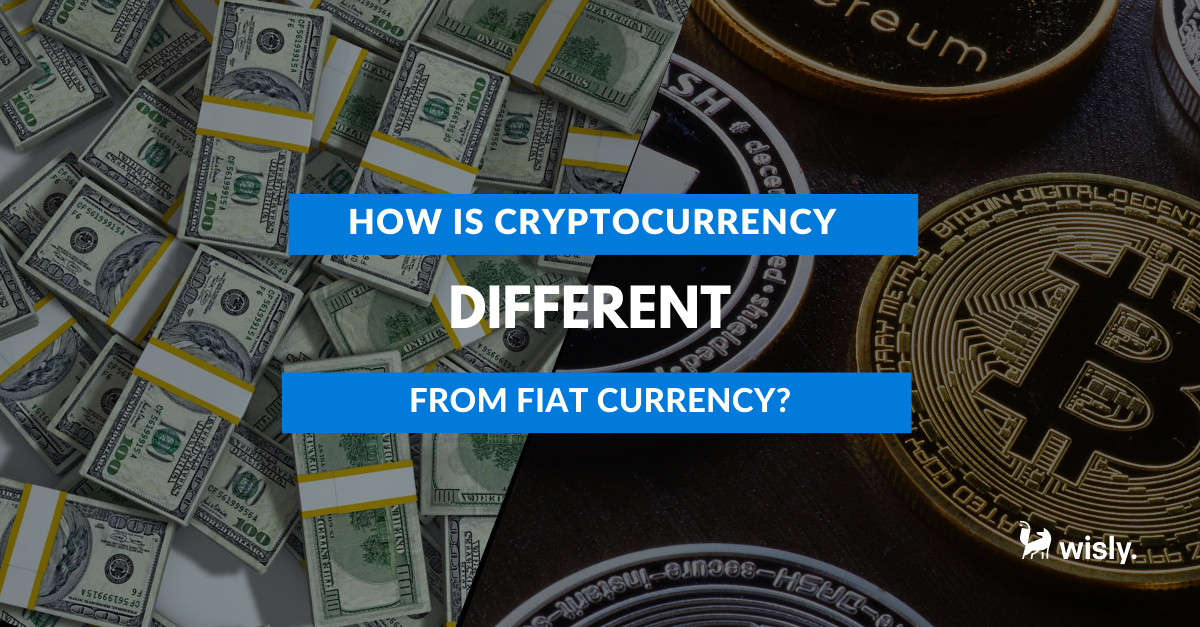Cryptocurrencies have enjoyed exponential success after the first cryptocurrency, Bitcoin, hit the scene more than a decade ago. Since the advent of the pandemic, interest levels in crypto have soared to unprecedented levels, with many coins scaling to record highs in 2021.
This incredible boost in value coupled with a flurry of new investors across the globe has made many people ponder the future of fiat money. Although cryptocurrencies may not be ready to replace fiat currencies as the preferred means of exchange around the world, it is worth understanding how they differ from traditional money.
Cryptocurrencies are different from fiat currencies as they are not regulated by financial authorities or backed by governments. Due to its decentralised nature, it is thought to be less credible than fiat currencies. Moreover, it is inherently volatile as it is driven by the speculative nature of the trade. Unlike fiat currencies, no intermediaries are required to validate crypto transactions as all transactions are verified using a blockchain – making it highly secure.
What are stablecoins?

A stablecoin is a category of cryptocurrencies that provides price stability to investors as it is backed by a reserve. They are extremely popular amongst crypto circles as investors get the best of both worlds – highly secure and instant transaction processing coupled with stable valuations of fiat currencies that are free of any volatility. Stablecoins can be described as a bridge between crypto and fiat currencies as they maintain their speed, security and low transaction costs while offering unrivalled price stability.
Considering that the short-term volatility of the majority of cryptocurrencies renders them unsuitable for everyday use by the public, it remains unsustainable as a medium of monetary exchange – a stark contrast when compared to the stability of fiat currencies. Stablecoins have four distinct categories that are each based on their unique working mechanism.
Fiat-collateralised stablecoins
Fiat-collateralised stablecoins use a fiat-currency reserve as collateral, such as US Dollar, in order to issue cryptocurrencies of a suitable number. The most common fiat-collateralised stablecoins make use of US Dollar reserves that are maintained by independent custodians. Moreover, they are audited on a regular basis to ensure that they are adhering to the necessary compliance. Popular stablecoins under this category include Tether (USDT), TrustToken, GUSD Paxos and TrueUSD.
Crypto-collateralised stablecoins
With crypto-collateralised stablecoins, these are backed by other cryptocurrencies. While this may appear to be counterproductive when considering their inherent volatility, such stablecoins are over-collateralised. Essentially, a greater number of crypto tokens are maintained as a reserve for issuing a smaller number of stablecoins. They may also be monitored and audited more frequently to provide more stability of the price. Popular stablecoins under this category include MakerDAO’s DAI and Havven.
Asset-collateralised stablecoins
Asset-collateralised stablecoins work very similar to fiat-collateralised stablecoins except that they use physical assets, such as gold or silver, as collateral. Stablecoins under this category are linked to a specific amount of the commodity and kept securely in a known location. It is subject to frequent monitoring and audits to ensure that its price remains stable. Under this category, collateral can include commodities like oil as well. Popular stablecoins under this category include Basis and Carbon.
Algorithmic stablecoins
This type of stablecoin appears to be the most complex by nature as it uses algorithms and smart contracts to safeguard the coin’s price stability. It does so by automatically decreasing or increasing its supply by using market forces in an effort to sustain a level price. There is no reserve that stabilises the price but instead uses a working mechanism to provide stability.

Pros and cons of stablecoins
Like other types of cryptocurrencies, there are great benefits to using stablecoins. These include low transaction fees, highly secure transactions, price stability, an easier bridge from fiat to crypto use, and compliance with fiat-related regulatory processes.
It is also important to note some of the disadvantages of using stablecoins. These include third-party authorisations, mandatory external audits and monitoring, lower return on investments, and strict adherence to regulatory procedures.
Final thoughts
Stablecoins have the potential to enhance the digital transformation of money by improving financial inclusion, lowering transaction fees, and enabling fast and secure cross-border transactions without inherent volatility.
While there is still some way to go before cryptocurrencies can be fully integrated into the mainstream, having stablecoins provides the perfect compromise between crypto and fiat currencies. Interestingly, it offers a glimpse of what the future of transacting could be like once cryptocurrencies become more widely accepted – truly exciting times indeed!
It is important to note that investing in cryptocurrencies is a risky and highly speculative proposition. This article does not provide recommendations, advice or guidance regarding cryptocurrencies investments but is rather our opinion on such activities. Investors must conduct their own research and engage in the services of qualified professionals before making any financial and/or cryptocurrency investment decisions. We do, however, recommend established platforms like Wisly to monitor and analyse your cryptocurrency investments.




